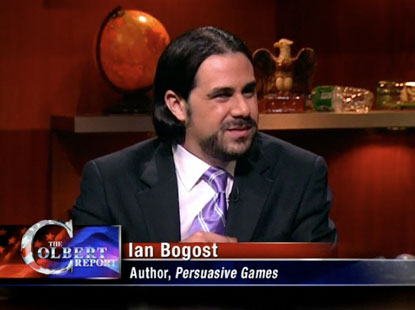I really enjoyed this chapter, while Gee offered a number of principles for what makes a good video game for learning, Bogost takes on the approach of the persuasive game. Gee's defense of games was also directed toward a much broader audience, while Bogost wants to further define the role of games within academic circles. Furthermore, Bogost deals with the current thoughts on games, and offers significant need for change in the way we think about games.
The largest term in the reading so far might also be the most difficult to understand. As Bogost states, both the terms procedure and rhetoric are often maligned in the public eye. Thus Bogost spends a significant amount of time defining his use of the two words. In terms of procedural, Bogost offers that the procedural elements are "the fundamental notion of the authoring process." (12) Bogost goes on to say that, unlike other forms of representation, procedural representation differs from other forms of representation in that it represents a process with a process. So while a painting might try to capture a still image or a movie might try to capture a sequence of events, a procedural representation might try to capture a certain set of decisions by reasonably replicating those decisions for the player of the game.
In terms of rhetoric, Bogost mainly cites an ancient sophistic perspective. Throughout the book Bogost likes to refer to the enthymeme-ic model of the way processes work, so that, in making a decision about the game play, the player must complete the enthymeme and make meaning (in terms of argument).
Explication on the Difference of Procedural Rhetoric
Bogost also writes at length on how procedural rhetoric relates back to ideas about oral, written, visual, and digital rhetoric. While discussing each of these facts would be too lengthy for my discussion here, it was interesting to see how he privileged procedural rhetoric in a number of ways. This is because scholars who study literature, film, or the internet so often look (more or less explicitly) at it within the idea of vividness. It is the realistic sense of the painting or the intense description which draw the viewer in in order for the material to be persuasive. Bogost contends that this is not a scale which works for describing procedural rhetoric, as it cannot capture the way that the very procedure itself is interesting and engaging. Later in the chapter, Bogost interestingly combats the concept of vividness further in saying that games move in a direction, not towards reality, but towards simulation. This furthers Bogost’s claim that the visual aspects of the game are less important than the way that the user becomes engaged with the game’s procedures. 
I wasn’t planning to write about this, but we can see the working side of the argument within the game Minecraft. Minecraft seems to use very elemental graphics, and the motion and physics are “blocky.” But it’s not about representing reality, about finding a way to replicate the exact forms of motion/vision that we see in the “real world.” Instead, Minecraft sticks to the elemental level in order to entice the user through procedures, through looking at the game as a form of process and less in terms of a specific sense of “vividness.” True, every iteration of the game includes things like rain, or sunsets, or other visual elements which might be said to be “realistic,” but in the end the game as a strong contingent of players because of what it allows the players to do, and not necessarily what it makes things look like. This can be said especially in terms of redstone circuitry.
Another important difference for Bogost was in differentiating procedural rhetoric from digital rhetoric. Bogost seems to look down on digital rhetoric because it doesn’t go far enough. What is called digital rhetoric, Bogost claims, is actually just the transfer of written and visual rhetoric to the digital realm, looking at how different programs effect the process of writing and reading on the computer. But this misses the way that the computer systems involve procedures, specific logical steps that the user must go through, and the way that these procedural steps are in and of themselves rhetorical.
In one of Bogost’s last contentions is in differentiating persuasive games (which is just finding procedural rhetoric in games) from the serious games movement. Bogost characterizes serious games as an institutionalized movement, where games are understood as a way to further the existing systems of the government, business, or education. While Bogost sees the benefit of such games in certain instances, he places persuasive games as the ability to work against the dominant paradigms as well as for them. While I do see the benefit of Bogost making this argumentative move, I don’t agree on his characterization of serious games, as I consider serious games as an approach to games which understands them as being able to entertain and instruct, much like the way Bogost characterizes persuasive games.
3 Questions
Considering the nature of procedural rhetoric, in what ways have the fields of written and visual rhetoric already began to stumble upon procedural elements of persuasion in their studies?
What is the relationship between vividness and procedure when it comes to persuasion? In what ways should the gameplay and visual elements be blended to create convincing games?
In what ways can we understand the relationship between visual and procedural elements in Minecraft? Can we even do so if Minecraft is less a game than a platform?
Images From:
http://www.bogost.com/images/content/blog/bogost-colbert_sm.jpg
http://static.gamesradar.com/images/mb/GamesRadar/us/Daily/2010/09-Sept/28/PCG%20Minecraft/PC-Gamer-Minecraft-cover1FULL--article_image.jpg

No comments:
Post a Comment